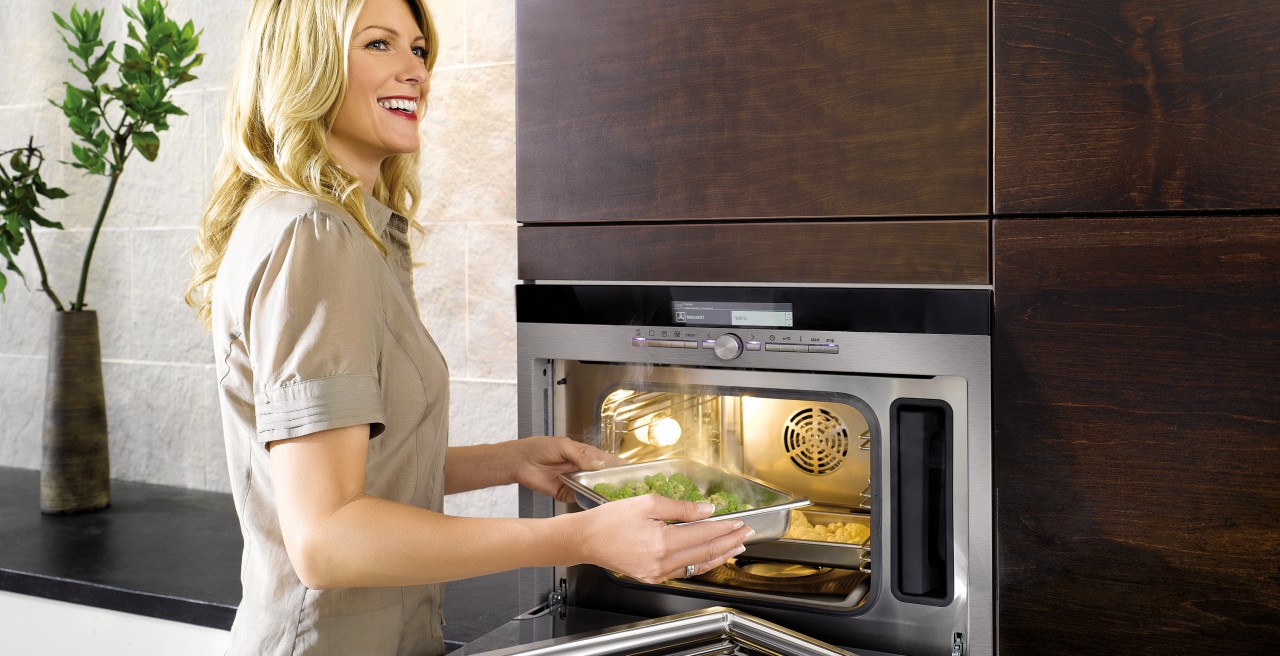Our everyday meals aren’t supposed to just fill our stomachs, but also to lift our spirits. You can do just that with high-quality ingredients and delicious recipe ideas. More and more people are realising the importance of preparing ingredients gently. Cooking with a steamer is particularly popular. This post tells you what makes steam cooking the perfect method for health-conscious cooks and how a steamer can be integrated into modern kitchen fittings.
Cooking with tradition: steam cooking goes back a long way
Even today, cooks at Chinese food stalls still cook rice, vegetables and small meat dishes in hot steam. A wok holds water that evaporates upwards. Above it are several stacked bamboo baskets containing the various ingredients and dishes. This cooking methods has an over 2,000-year tradition in China. Even if it is forgotten today, cooking in our own country is strongly rooted in this tradition, too. Pressure cookers and clay pot cooking are based on the same principle as a modern steamer. The benefit of such methods is that they cook food particularly gently.
Health-conscious cooking: preserving vitamins
In steam cooking, the steam rises and envelops the ingredients. These are exposed to a constant level of heat, allowing them to cook slowly. Vegetables, meat, pasta and fish barely come into contact with the boiling water. As such, the minerals and vitamins in the food are preserved, rather than flushed out by the cooking water. This is particularly important for water-soluble vitamins like B-vitamins and vitamin C. Gently cooking also keeps vegetables firm and meat succulent. The flavours do not end up being poured away down the drain with the cooking water, but rather remain in the ingredients. As such, a steamer is a vital stalwart of any professional kitchen. Even home cooks don’t want to be without this kitchen appliance once they have experienced what it can do.
BLANCO ZENAR – a sink adapted to the steamer
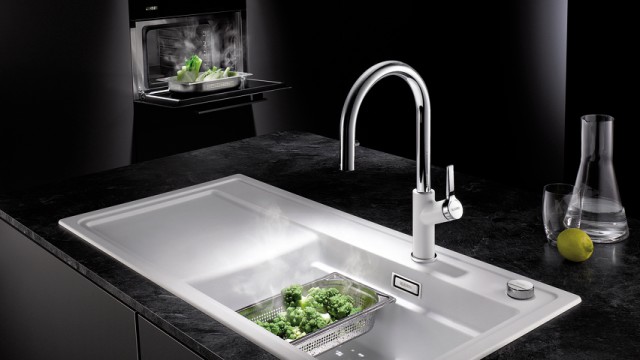
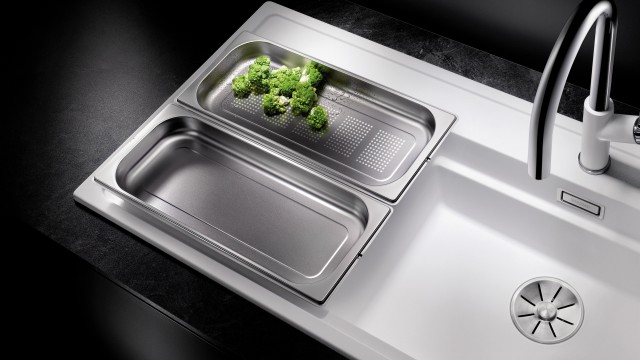
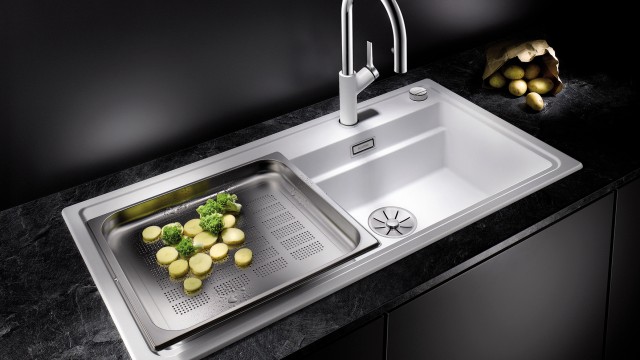
How steam cooking works
Steamers all essentially work in the same way. They have an upper part that contains the ingredients. This is inserted into the appliance. Beneath the steam cooking container is receptacle holding water, which is heated to a simmer at about 100 degrees Celsius. During the steaming process, the steam surrounds and cooks the ingredients. Depending on the appliance, various setting allow you to adjust the cooking time for the ingredients.
If you’re not sure whether the steamer will fit in with your cooking habits, you can try out the method using a conventional cooking pot. Attach a fitting steamer insert over a pot containing a little water. Close the lid and heat the water. You’ll notice that broccoli, carrots and other vegetables cook much quicker than they would if you boiled them in water. The very quick preparation time is another advantage of steam cooking.
How to integrate a steamer into your kitchen effectively
In most cases, steam cooking is faster than other methods. As such, your cooking preparations and the design of the kitchen need to be adapted to the newfound speed of this type of cooking. Imagine first filling the steamer with meatballs, which take a little longer to cook. In the last third of the cooking time, you need to add the beans to another steam cooking container, so that the two components of your dish are cooked at the same time. This kind of coordination requires you to structure your workflow strictly. The steamer needs to be right beside the sink and the worktops, to keep your paths within the kitchen. You can simplify the preparation of ingredients by quickly disposing of kitchen waste in a waste bin . If this is directly integrated into the kitchen worktop, your worksurfaces remain clean.
What your kitchen needs for perfect steam cooking
Modern kitchen fittings are adapted to steam cooking. Previously, the oven was the focal point of the kitchen, so it stood near the sink. These days, you should position your steamer within easy reach of the sink. The special BLANCO steamer sinks are generously sized and feature clever details that make cooking with a steamer easier. Extra-large steam cooking containers can be placed on the spacious drainer, allowing you to add the ingredients there. The prepared food can be kept for as long as you need in a bowl, either on a set of Top-Rails or in a Corner-Caddy in the sink itself.
After cooking, you can place the steam cooking container on the drainer again. You can transform the sink beside it into an additional worktop using the matching cutting board. Plates or bowls can be set down here for you to arrange the food. The sink contains steps that allow you to attach the steam cooking container once the food is done. This is practical because the wet steam cooking container can drain there, without getting the worktop all wet. Even large steam cooking containers fit into the BLANCO XL sinks, making them particularly easy to clean after using.

How to determine the right place for your steamer
Steamers come in a wide array of models. Steam cookers often have a rounded shape. You put the ingredients in the steamer baskets, which are stacked on top of one another. If you are going to be using your steamer every day, you’ll find a standing steamer particularly useful. It resembles a microwave in appearance and has several levels that offer enough space to cook fish, pasta and vegetables for several people. In a modern kitchen designed in an industrial or minimalist style, an inbuilt appliance will work best with the overall design. Inbuilt steamers are integrated into the row of kitchen units in the same way as an oven. This saves storage space for moveable appliances and allows you to install your steamer at a height that won’t hurt your back.
Where the steamer comes into play
Which ingredients can you prepare in a steamer these days? The possibilities really are almost limitless.
These basic ingredients are suitable for steam cooking:
- Vegetables: cut vegetables into pieces that are as evenly sized as possibly, so that they are evenly cooked through.
- Pasta and rice: for this you need a cooking container without holes, as unlike vegetables, you will need to add a little extra water to pasta and rice. The cooking process will take a few minutes longer than conventional boiling in water.
- Fish and seafood: it takes around ten minutes to cook a fillet of fish weighing around 500 grams. Prawns only take five minutes.
- Meat: you can also cook poultry, pork and beef in your steam cooker. If you want a crispy skin, you should then pan-fry the meat or roast it in the oven.
You can cook both fresh ingredients and frozen food in a steamer. Herbs and marinades can be added directly to the steam cooking container to jazz up vegetables or fish. If you like trying out new things and want to conjure up a dish with a difference, put stock or wine in the steamer, instead of water. You can usually do without adding salt, pepper and other seasonings, as the natural flavours of the food really come through with steam cooking.
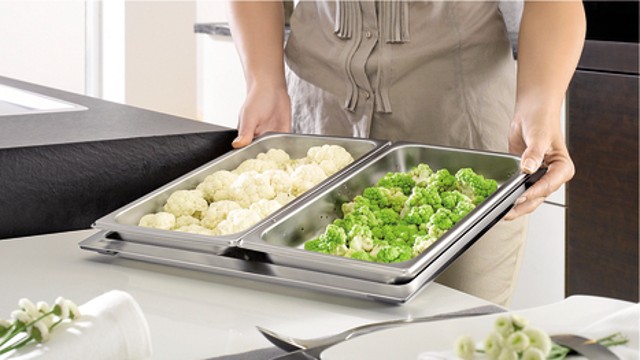
As you can see, a steamer is practically a must in the kitchen of any health-conscious cook. There are suitable appliances for professional chefs and home cooks alike. If you want to integrate steam cooking into your kitchen in the long term, you will find clever sink systems and accessories that make steam cooking easier and even more enjoyable.
